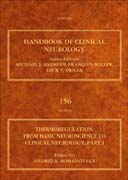
Thermoregulation Part I: From Basic Neuroscience to Clinical Neurology
Romanovsky, Andrej A.
Thermoregulation, Part I: From Basic Neuroscience to Clinical Neurology, Volume 154 not only reviews how body temperature regulation changes in neurological diseases, but also how this aspect affects the course and outcomes of each disease. Other sections of the volume review three therapeutic approaches that are aimed at manipulating body temperature, including induced hypothermia, induced hyperthermia and antipyretic therapy. The book is comprised of nine sections across two volumes, five dealing with the basic aspects of body temperature regulation and four dealing with the clinical aspects. Basic sections cover the Thermoregulation system, Thermoreceptors, Thermoeffectors, Neural pathways, and Thermoregulation as a homeostatic function. In addition, the book covers the physiology and neuroanatomy of the thermoregulation system and provides descriptions of how the regulation of body temperature intervenes with other physiological functions (such as sleep, osmoregulation, and immunity), stress, exercise and aging. Basic sections serve as an introduction to the four clinical sections: Body Temperature, Clinical Significance, Abnormal Body Temperature, Thermoregulation in Neurological Disease and Therapeutic Interventions. Presents a clear, logical pathway from the fundamental physiology of thermoregulation, through neurobiology, to clinical applications and diseaseEnables researchers and clinicians to better understand the value of temperature measurement in disease and the use of temperature as a therapy Integrates content from a broad field of research, including topics on the molecular physiology of temperature receptors, to the management of accidental hypothermia INDICE: Section I. THERMOREGULATION SYSTEM 1. The thermoregulation system and how it works Section II. THERMORECEPTORS 2. Peripheral thermoreceptors in innocuous temperature detection 3. Molecular basis of peripheral innocuous cold sensitivity 4. Molecular basis of peripheral innocuous warmth sensitivity 5. Peripheral thermoreceptors in wetness perception 6. Nociceptors. Thermal allodynia and thermal pain 7. Central thermoreceptors 8. Molecular basis of central thermosensitivity Section III. THERMOEFFECTORS 9. Brown adipose tissue as a heat-production thermoeffector 10. Shivering and non-shivering thermogenesis in muscles 11. Skin vasoconstriction as a heat-conservation thermoeffector 12. Skin vasodilation as a heat-loss thermoeffector 13. Sweating as a heat-loss thermoeffector 14. Panting as a heat-loss thermoeffector 15. Thermal comfort Section IV. NEURAL PATHWAYS 16. Afferent neural pathways for autonomic thermoeffectors and shivering 17. Efferent neural pathways for the control of brown adipose tissue thermogenesis and shivering 18. Efferent pathways for thermoregulatory skin vasomotion and sweating 19. Neural pathways for temperature discrimination, thermal comfort, thermal pain, and thermoregulatory behaviors Section V. THERMOREGULATION AS A HOMEOSTATIC FUNCTION 20. Body temperature and sleep 21. Skin temperature and sleep 22. Thermoregulation and the ultradian basic rest-activity cycle 23. Thermoregulation and age 24. Temperature and adaptive immunity 25. Homeostatic interactions between osmo- and thermoregulation 26. Thermoregulation and obesity 27. Thermoregulation and nausea 28. Body temperature and neurogenesis
- ISBN: 978-0-444-63912-7
- Editorial: Elsevier
- Encuadernacion: Cartoné
- Páginas: 364
- Fecha Publicación: 01/06/2018
- Nº Volúmenes: 1
- Idioma: Inglés
